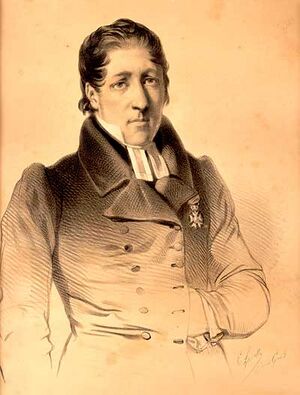Contents |
Biography
Lars Levi was born in 1800. He passed away in 1861.
Lars Levi Læstadius, born January 10, 1800, in Jäckvik in Arjeplog parish, died February 21, 1861, in Pajala parish in Norrbotten, was a Swedish priest. He was the son of Carl Læstadius.
Læstadius became the leader of the ecclesiastical revival movement that came to be named after him, Læstadianism. He was also a prominent botanist, author of several books and writings, and a powerful advocate for total abstinence from alcohol.
Accomplishments
- Student at Härnösand Gymnasium 1816–1819
- Enrolled at Uppsala University October 24, 1820,
- Graduated from the theological seminary in December 1822,
- Ordained in Härnösand February 20, 1825,
- Oversaw missionary service in Arjeplog and Arvidsjaur, Norrbotten, 1825–1826,
- Pastor in Enontekis (now Karesuando), Norrbotten, from May 18, 1825 (assumed office March 1826),
- Passed pastoral examination in Härnösand December 5, 1843,
- Appointed to undertake a visitation journey in the Sami areas December 13, 1843,
- Vicar in Pajala from October 27, 1848,
- Published the magazine "A Crying Voice in the Wilderness" January 1852–December 1854 (publishing permission December 10, 1851).
- Revivalist preacher
- Member of the Royal Swedish Academy of Sciences 1839.
He married Brita Catarina (Kajsa) Alstadius in Karesuando, Norrbotten on April 1, 1827 (born February 8, 1805, in Kvikkjokk, Jokkmokk, Norrbotten, died March 4, 1888, in Pajala, daughter of the settler Olof Ersson A. and Catharina Govenius.). They had 15 children, of whom twelve reached adulthood. He was the brother of the priest Petrus Læstadius and the great-grandfather of the theater director and playwright Lars-Levi Læstadius.
Children
- Eleonora Laestadius 1827–1874
- Emma Maria Laestadius 1828–1828
- Carl Johan Laestadius 1829–1890
- Sofia Wilhelmina Laestadius 1831–1898
- Emma Kristina Laestadius 1833–1882
- Elisabeth - Lisa Laestadius 1836–1896
- Levi Laestadius 1836–1839
- Lorentz Vilhelm Laestadius 1839–1866
- Fredrica Johanna Laestadius 1840–
- Hedvig Charlotta Laestadius 1842–
- Lea Selma Laestadius 1844–1872
- Gustaf Leonard Laestadius 1847–
- Daniel Laestadius 1851–1861
Controversy
Lars Levi Læstadius was a Swedish pastor and the founder of Laestadianism, a revival movement within the Lutheran church. His influence and the controversies surrounding him mainly stem from his religious activities and the movement he initiated.
- Revival Movement and Strict Doctrine: Læstadius sparked a revival movement in the 19th century, particularly among the Sámi people in northern Scandinavia. His preaching emphasized personal conversion, strict adherence to Biblical teachings, and a pietistic lifestyle. This approach was often at odds with the more liberal and institutional practices of the Lutheran Church at the time, leading to tensions.
- Cultural Impact on Indigenous Communities: One of the major controversies surrounding Læstadius involves his impact on the Sámi people. While he was part Sámi himself and worked extensively to improve their spiritual and social conditions, his movement also led to significant cultural changes. It contributed to the decline of traditional Sámi religious practices and shamanism, seen as a form of cultural erosion.
- Conflict with Lutheran Establishment: Læstadius often found himself in conflict with the established Lutheran church and its clergy. His unorthodox methods and teachings were sometimes seen as fanatical or heretical. This led to a divide between his followers and the mainstream church, with some followers forming their own separate congregations.
- Influence on Sobriety and Social Reform: On a positive note, Læstadius and his movement are credited with promoting sobriety among his followers, especially important in communities struggling with alcohol abuse. His teachings emphasized moral rectitude and personal responsibility, which led to social reforms in some areas.
- Legacy and Sectarianism: After his death, the movement he started split into various factions, each interpreting his teachings differently. This fragmentation has led to ongoing debates and controversies within Laestadianism about the correct interpretation of Læstadius's teachings and the direction of the movement.
Overall, Læstadius is a complex historical figure, revered by many for his spiritual leadership and social reforms but also criticized for the cultural and religious impacts of his movement. His legacy continues to influence religious and cultural discussions in Scandinavia and among Laestadian communities worldwide.
Sources
- Swedish Household Record / Husförhörslängder: Between 1772 and 1826 - Arjeplog Nybyggare, Arjeplog, Norrbottens, Lappland, Sweden. Arjeplog AI2, 1772 - 1826. Arjeplogs kyrkoarkiv, Husförhörslängder, SE/HLA/1010006/A I/2 (1772-1826), bildid: C0034665_00038, sida 37. https://sok.riksarkivet.se/bildvisning/C0034665_00038
- Burial: Find a Grave, database and images (https://www.findagrave.com/memorial/196756222/lars_levi-læstadius: accessed February 18, 2024), memorial page for Lars Levi Læstadius (10 Jan 1800–21 Feb 1861), Find A Grave: Memorial #196756222, citing Pajala Cemetery, Pajala, Pajala kommun, Norrbottens län, Sweden; Maintained by Hjärtats Kärlek (contributor 49534244).
Further Reading
- Samer.se: Lars Levi Laestadius och samerna (Accessed 18 Feb 2024) https://www.samer.se/laestadianismen
- Wikipedia-Swedish https://sv.wikipedia.org/wiki/Lars_Levi_Læstadius
- Wikipedia-English https://en.wikipedia.org/wiki/Lars_Levi_Laestadius
- Lars Levi Laestadius, https://sok.riksarkivet.se/sbl/artikel/10824, urn:sbl:10824, Svenskt biografiskt lexikon (art by Olle Franzén) from 2024-02-17.
No known carriers of Lars Levi's ancestors' DNA have taken a DNA test.
Have you taken a DNA test? If so, login to add it. If not, see our friends at Ancestry DNA.
Featured National Park champion connections: Lars Levi is 26 degrees from Theodore Roosevelt, 29 degrees from Stephanus Johannes Paulus Kruger, 26 degrees from George Catlin, 29 degrees from Marjory Douglas, 34 degrees from Sueko Embrey, 24 degrees from George Grinnell, 31 degrees from Anton Kröller, 26 degrees from Stephen Mather, 31 degrees from Kara McKean, 30 degrees from John Muir, 24 degrees from Victoria Hanover and 37 degrees from Charles Young on our single family tree. Login to find your connection.
L > Læstadius > Lars Levi Læstadius
Categories: Sweden, Needs Profiles Created | Pajala (BD) | Pajala Cemetery, Pajala, Norrbotten | Arjeplog (BD) | Sweden, Notables | Notables


